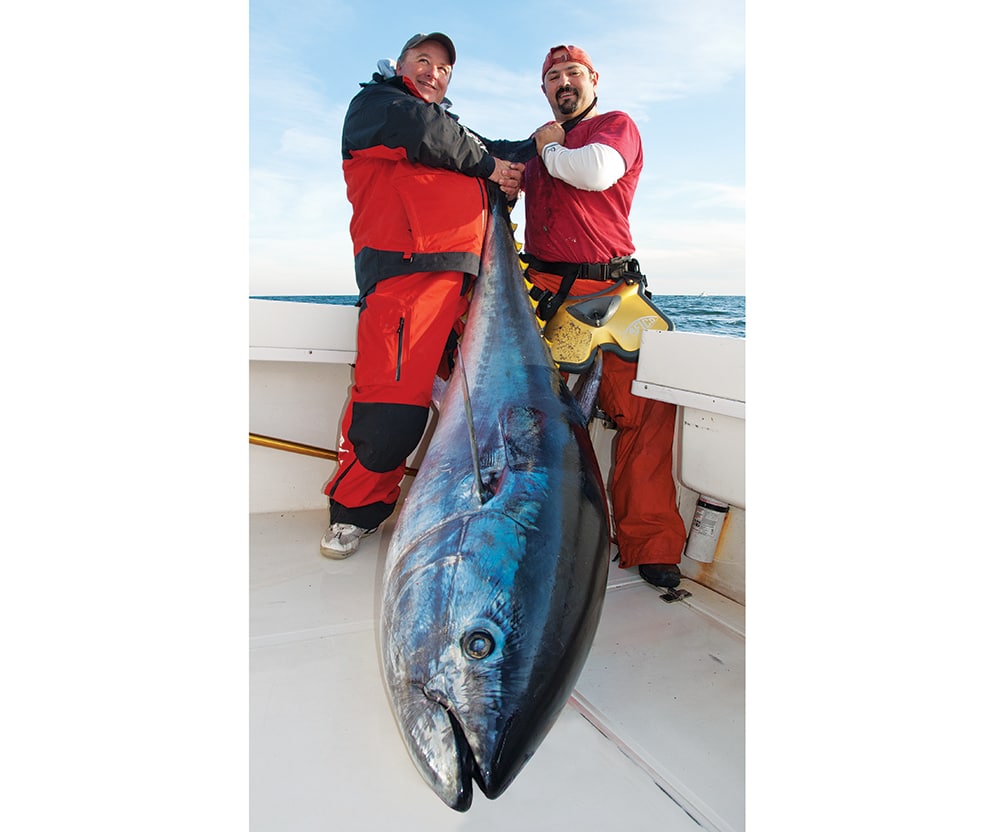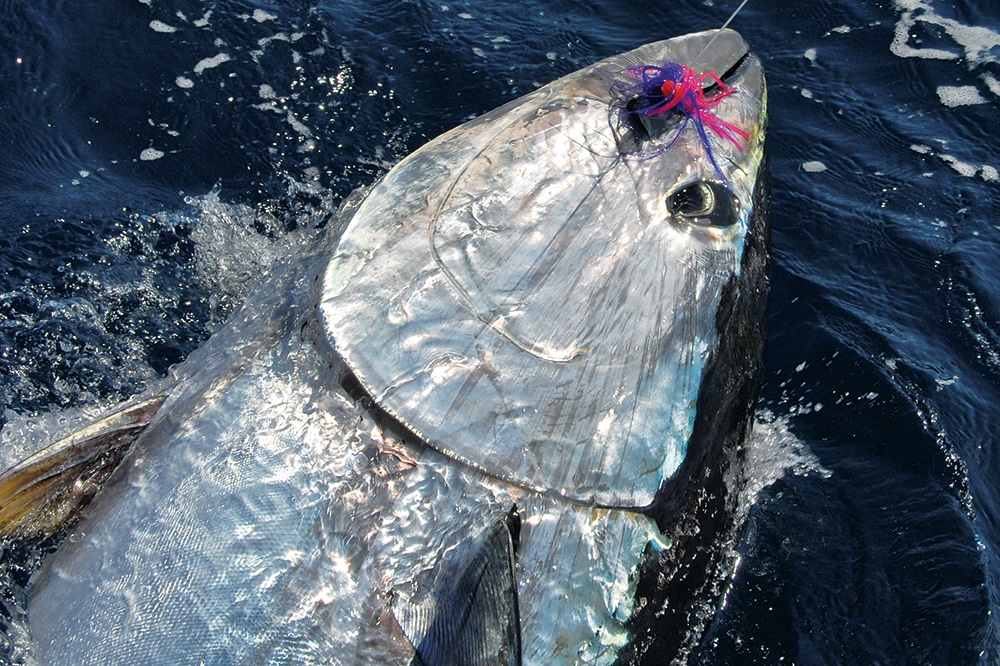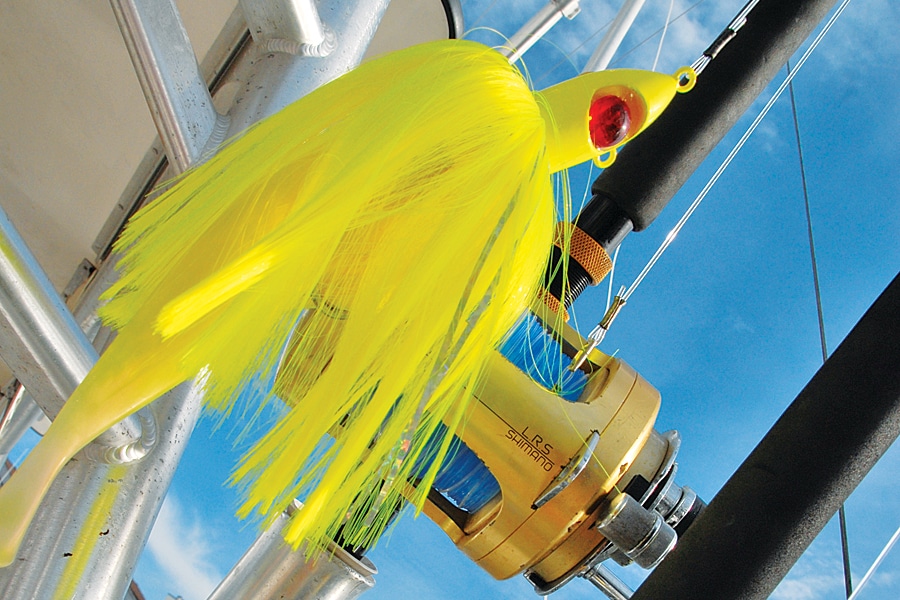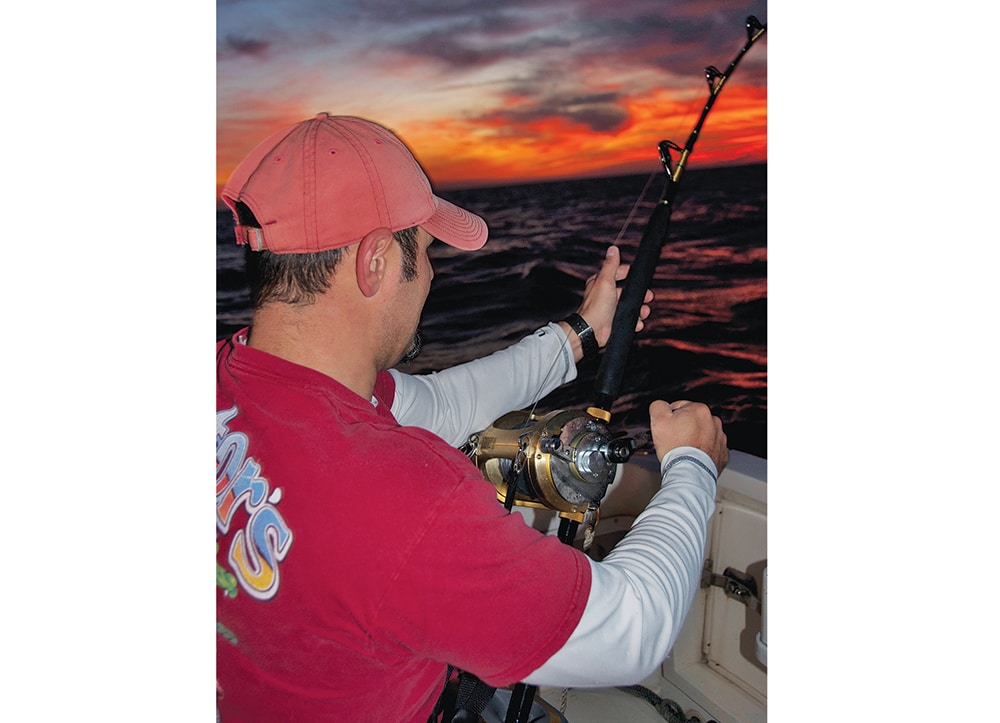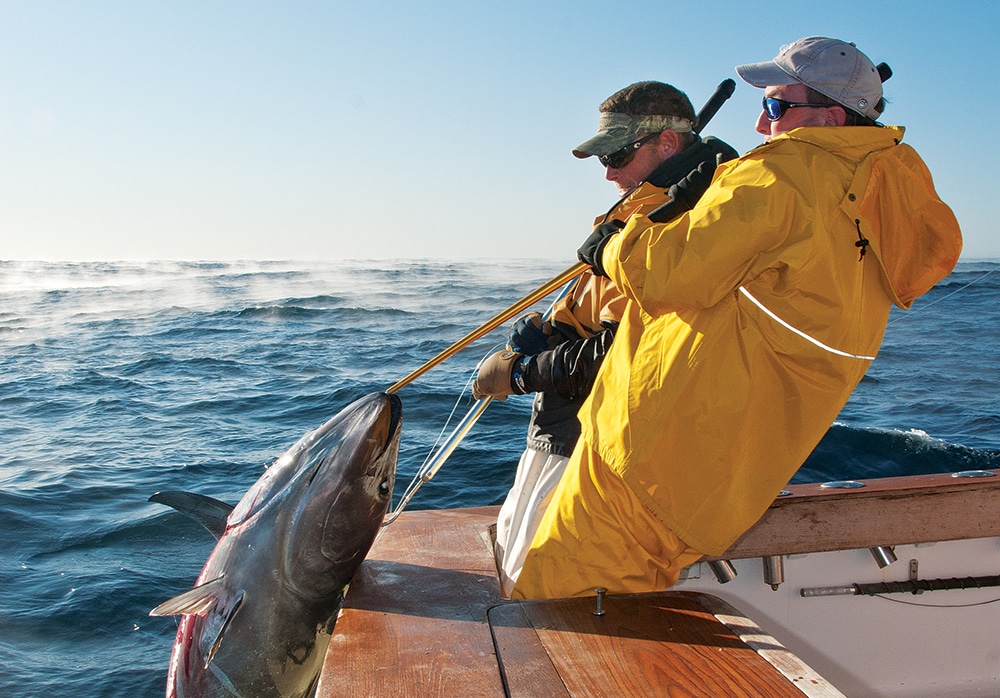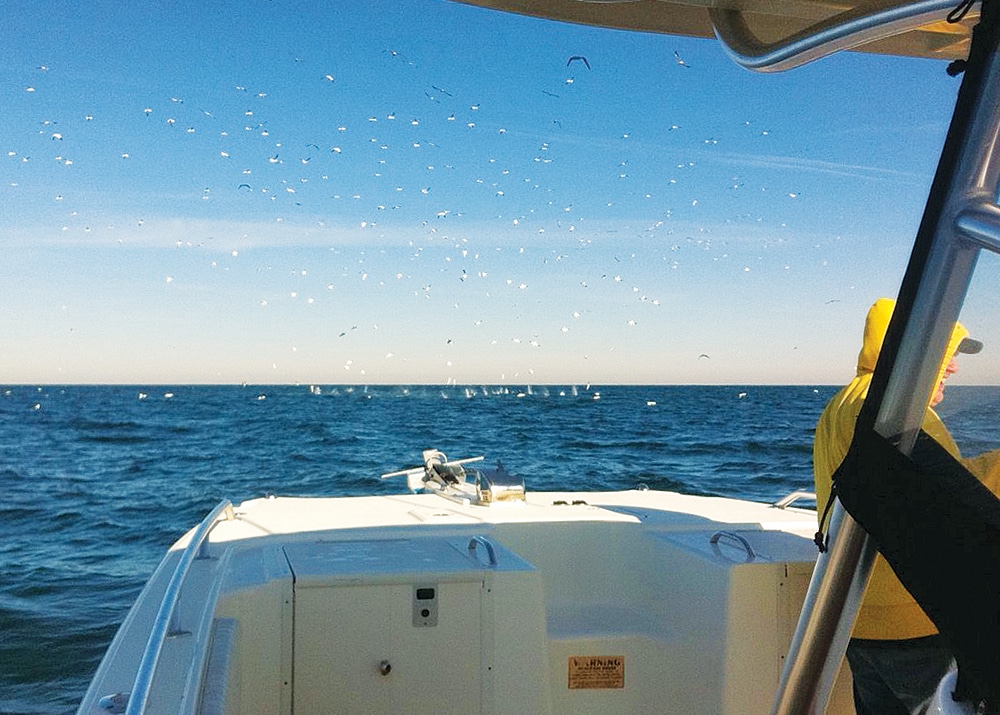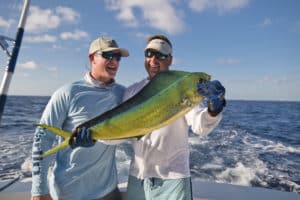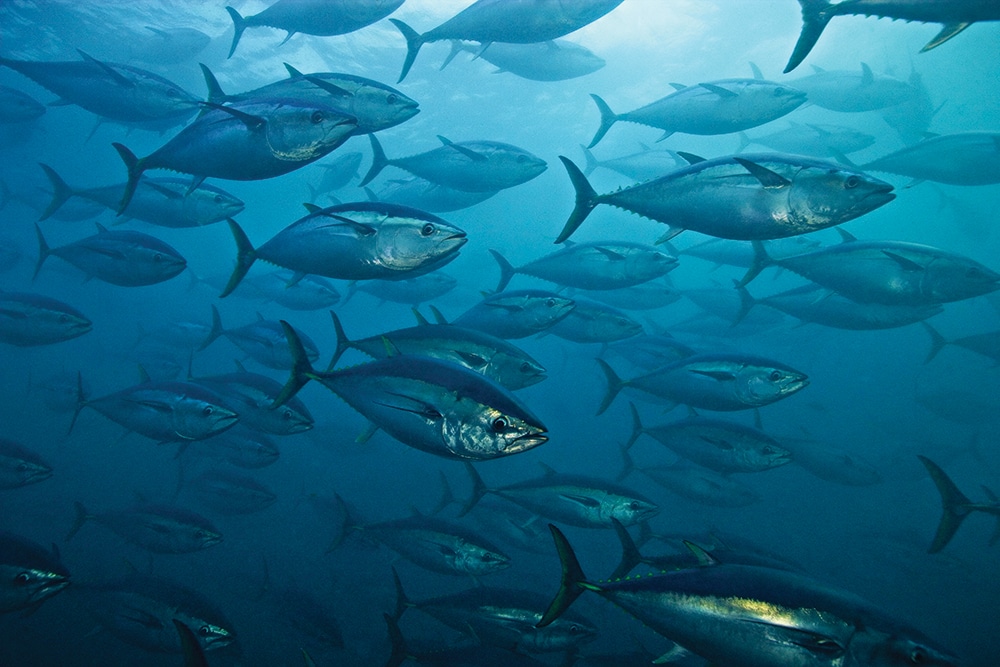
Three winters ago, on a cold December morning, Capt. Pat Foster was slow-trolling for striped bass off the Virginia Beach oceanfront when he got a big bite. “The fish hit hard,” he recalls, “then it just stopped.” At first Foster thought he had a trophy rockfish, until the line started screaming off the reel.
Before he could clear the other rods and turn the boat, all of the line on Foster’s Penn 113H Senator was gone, and with it, his fish. Foster scratched his head, wondered with awe what had stolen his tackle, and then went back to rockfishing.
A few miles away, Ken Neill was trolling for stripers in his 31-foot Albemarle, Healthy Grin, when he got a big bite too. “It didn’t last long,” Neill chuckles. “The fish took everything.”
Over the next few hours, the VHF radio crackled with chaotic reports of other skippers facing similar encounters. “Guys were getting spooled, burned off, crossed up, even losing rods and reels to mystery bites,” Neill remembers.
Back at the dock, stories of close encounters with large bluefin tuna trickled in. “One guy told me, ‘All I had left was a memory,'” Foster laughs. At the time, fishing regulations prohibited capturing one of these beasts, so Foster continued to focus his efforts on striped bass. “The next day we fought a bluefin for an hour and a half on striper tackle before releasing it,” Foster recalls. “Obviously something was going on.”
When bluefin season reopened a few days later, Foster and Neill returned to the striper grounds loaded for bear. “I was ready to make those fish pay,” Neill jokes. And pay they did.
Bluefin Bonanza
Bluefin tuna are no stranger to the Virginia coast. In late spring and late fall, the fish swing past the Commonwealth on their migration between New England and Cape Hatteras. “They can show up anywhere from Chesapeake Light Tower to the Fingers, about 20 to 50 miles offshore,” Neill says.
But when these bluefins showed up in the middle of winter, they were swimming within sight of the beach. “We were catching fish in 38-degree water right outside the inlet,” Neill shakes his head. “I’d never seen anything like it.”
While anglers fishing for striped bass have caught bluefin before, those stories are rare. No one could have imagined a reliable run of 100- to 300-pound bluefin tuna within sight of Virginia Beach’s resort hotels.
In fact, during the early part of 2012, anglers caught big bluefin from the North Carolina state line to Virginia’s Eastern Shore — most within a few miles of the beach. Foster says this presented a conundrum: How do you fish for bluefin tuna and striped bass at the same time? The answer is a hybrid mixture of tuna gear and rockfish tactics that produced amazing results and unbelievable catches.
Loaded for Bear
Virginia anglers like Foster and Neill are experts at scoring big bluefin. “During spring and fall, we usually troll horse ballyhoo on Ilander skirts with 80-pound outfits,” Neill says. Due to the explosive power of a large bluefin, Neill’s crew limits their spread to three baits fished way back behind the boat. “We run one bait 150 to 200 feet behind a downrigger, about 25 to 40 feet down,” he says, “and the outrigger baits are out half to a third of the line on the reel.”
Neill trolls his rigs at 5 to 7 knots over the humps and hills that dot the bottom from Triangle Wrecks east to Norfolk Canyon, and from Cigar off North Carolina up the coast to Lumpy Bottom out of Wachapreague.
But these spring and fall tricks didn’t work on the unprecedented run of winter bluefin. “The water was cold and the fish were feeding on menhaden,” Neill says. “We had to use different tactics.”
Foster and Neill are also experts at catching striped bass in winter. “When the striper show up around Thanksgiving,” Foster says, “we troll tandem parachute rigs at 2 to 3 knots.” A parachute jig is a big bucktail rigged with an 8- to 12-inch rubber shad. The nylon hair on the jig is tied in reverse so it bulges out around the lead-head, which gives the parachute its name.
Most anglers fish two parachute jigs from each rod. This tandem rig starts with a 250-pound-test three-way swivel. From one eye of the swivel, Foster pulls a heavy jig on a 6-foot dropper. From the other eye of the three-way, he runs 12 feet of leader and a lighter jig. “We use 64-ounce and 12-ounce tandems up to 8-ounce and 4-ounce,” he says.
“When the bluefin showed up, so many anglers were hooking them on striper gear, it made sense to use striper lures for tuna,” Foster says.
To beef up his striper gear for bluefin, Foster rigged his parachute jigs on 80-pound tackle. “I used a single parachute crimped to 30-foot leader of 200-pound-test monofilament,” he says. A 380-pound-test wind-on swivel connected the 200-pound leader to a 300-yard top shot of 100-pound monofilament. The leader was attached to a reel full of 150-pound braid with a double-loop connection.
When he targets winter bluefin, Foster pulls only a half-dozen lines. His spread starts in the transom with two rods bouncing 64-ounce parachutes across the bottom. He runs a 40-ounce parachute from each short rigger and pulls 28-ounce parachutes from the outriggers. “The rule of thumb is to drop the parachute back until it hits bottom, then put the reel in gear,” he adds.
“At first I worried that the parachutes wouldn’t hold up to the bluefin,” Foster admits. “Or maybe the heavy lead jig head would pull the hook out of the fish’s mouth.” But he says his fears were unfounded. “I don’t think we lost a single fish because of the parachutes,” he says.
When the bluefin showed, weekend warrior Neill lost all interest in striped bass. “With 300-pound tuna swimming a few miles off the beach,” Neill laughs, “it was hard to think of anything else.” Neill concocts a mixture of striper and tuna lures to cover the bases. On the flat lines, he uses a tandem parachute rig with a 64-ounce jig on the dropper, and an Ilander and big ballyhoo on the longer leader. “We use the biggest three-way swivel we can find and replace the 100-pound leader with 200-pound mono,” he says. He pulls a 10-ounce and 5-ounce parachute combo from one short rigger, and a 6-ounce and 3-ounce tandem from the other. Each long rigger drags an Ilander and horse ballyhoo. “We hook fish on everything,” he says. “The most important thing is to use tackle heavy enough to handle these big fish.”
Trolling speed for tuna is typically 5 to 6 knots, but Neill and Foster slow-troll at 2 to 4 knots. “That allows the parachutes to bounce off the bottom in 25 to 60 feet, where we get most of our bites,” Neill says. “The Ilanders seem to work just fine at slow speeds.”
Glory Hunting
Each winter, hordes of anglers invade Virginia Beach to chase the schools of big rockfish returning to Chesapeake Bay. When the bluefin tuna appeared, hundreds of anglers were already on the water fishing for striper.
In that situation, “the biggest challenge to catching one of these tuna is getting the fish out of the crowd of boats,” Foster says. Many anglers lost fish to cut lines and crossed tempers. “When I would target tuna,” he adds, “I would try to find the fish away from the fleet.” That usually meant hitting lumps and hills outside 3 miles from the beach where striper fishing is prohibited.
“Look for diving gannets and breaching whales, or keep an eye out for bait marks on the fish finder,” Neill adds. Foster found bluefin tuna feeding under small terns that were picking anchovies and sand eels off the surface.
Hot spots included the deep water off Cape Henry and the lumps from Damn Neck south to the 4A Drydock off Corolla, North Carolina. Boats that ran north, and fished the sloughs and ridges within sight of Cape Charles Light also found bluefin mixed in with striped bass.
Both skippers agree that the best time to catch bluefin is just before dawn and just after sunset. “But these fish will feed all day,” Neill says, “especially if it is overcast or rough.” And many anglers reported bites at the change of the tide. “It’s hard to put together a scenario for these fish,” Neill admits. “We just don’t catch enough of them.”
In fact, in a dozen trips Neill landed only a handful of tuna, and released several more at the boat. Foster landed 10 tuna total and released twice as many. A year later, both skippers and hundreds of other anglers waited impatiently for the tuna to return. “Everyone wondered whether the run was a freak thing or a regular event,” Neill says. So when the first bluefin were caught this past winter, anglers breathed a sigh of relief and took up the chase again. “Last year the fish were caught farther offshore around Chesapeake Light Tower,” Foster says. “That made it easier to target them without worrying about striped bass.”
So what about this year? “My fingers are crossed,” Neill says. “I can’t wait for winter!”
Bizarre Bluefin
While Virginia Beach anglers were shocked to see bluefin tuna in the middle of winter, marine biologists weren’t. “If we’ve learned anything over the past 20 years working on Atlantic bluefin tuna,” says Molly Lutcavage, a research scientist at the University of Massachusetts, “it’s that they shift their dispersal routes over the years and decades.”
From the 1950s to ’70s, fishermen sight-fished for massive bluefin tuna off the Bahamas, in an area known as Tuna Alley. The narrow region of Great Bahama Bank that runs north from South Cat Cay was legendary for its schools that traveled in crystal-clear water over sandy bottom. Today, the Bahamas’ bluefin fishery is just a shadow of its past.
Lutcavage points to the awesome run of bluefin off Hatteras in the late ’90s. Then that bite slowed, and the fish were caught in other locations, such as Virginia, she says. Now it seems that the tuna are moving into Virginia Beach on their way to the Gulf of Mexico. “They swing inshore to top off their lipid reserves,” Lutcavage explains.
As for the cold winter water, Lutcavage isn’t surprised. “Bluefin are warmblooded,” she says. “They have been recorded in water as cold as 32 degrees.”
Then the big question is: Will the fish return this year?
Rules and Regulations
• For the latest Virginia fishing regulations, visit mrc.state.va.us.
• Check federal seasons and limits for bluefin tuna at hmspermits.noaa.gov.
Drop a Line
• Capt. Pat Foster, Wave Runner, 757-377-5018, vbsportfishing.com
• Ken Neill, facebook.com/healthygrinsportfishing
About the Author: _After sweating and cursing for two hours while cranking in a 500-pound bluefin tuna 20 years ago, Ric Burnley retired from the fighting chair, and took up photography and writing. He currently lives in Virginia Beach, Va., where he teaches high school students, and fishes for anything that doesn’t require straps and a harness to fight. _

